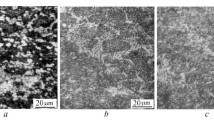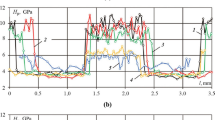Conclusions
-
1.
A study of the temperature fields during cooling after surface heating demonstrated the possibility of accelerating heat removal from inner layers by a factor of 2–2.5.
-
2.
The use of intensive spray cooling after surface heating leads to an increase in the depth of the hardened layer largely due to the increase in the depth of the martensite layer.
-
3.
With intensive spray cooling after surface heating of steel 45 of average chemical composition (diameter 40–80 mm) it is possible to obtain a depth of the martensite layer 1.75–2.5 times larger and a depth of the hardened layer 1.25–1.5 times larger than after through heating.
-
4.
Quenching of steel 45 by means of intensive spray cooling to a depth larger than 4 mm hardly increases the surface hardness as compared with spray cooling after through induction heating.
Similar content being viewed by others
Literature cited
G. F. Golovin and M. M. Zamyatnin High-Frequency Heat Treatment [in Russian], Mashinostroenie, Moscow (1968).
K. Z. Shepelyakovskii, Hardening of Machine Parts by Surface Quenching with Induction Heating [in Russian], Mashinostroenie, Moscow (1972).
N. V. Zimin and M. M. Zamyatnin, “Theoretical and experimental studies of the distribution of cooling rates during surface quenching”, in: Use of High-Frequency Current in Electrothermics [in Russian], Mashinostroenie, Leningrad (1968), p. 110.
K. Waitzmann, Materialprüf,1, No. 8, 261 (1959).
N. V. Zimin, “Kinetics of cooling of surface-heated steel parts”, in: Use of High-Frequency Current in Electrothermics [in Russian], Mashinostroenie, Leningrad (1973), p. 74.
N. V. Zimin and V. A. Lifshits, “Effect of intensification of cooling on suppression of tempering of martensite in the process of quenching carbon steels”, in: Commercial Use of High-Frequency Current [in Russian], Trudy VNIITVCh, No. 11, Mashinostroenie, Leningrad (1970), p. 137.
N. V. Zimin, M. M. Zamyatnin, and G. F. Golovin, “Effect of spray cooling on the hardenability, hardness, and structure of martensite in carbon steel”, in: Metallurgy and Coal Tar Chemistry [in Russian], No. 36, Tekhnika, Kiev (1973), p. 35.
Additional information
V. P. Vologdin All-Union Scientific-Research Institute of High-Frequency Current. Translated from Metallovedenie i Termicheskaya Obrabotka Metallov, No. 1, pp. 22–27, January, 1978.
Rights and permissions
About this article
Cite this article
Zimin, N.V. Structure and properties of the hardened layer with intensive spray cooling after surface heating. Met Sci Heat Treat 20, 22–27 (1978). https://doi.org/10.1007/BF00670436
Issue Date:
DOI: https://doi.org/10.1007/BF00670436




